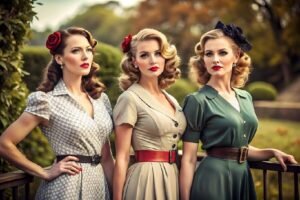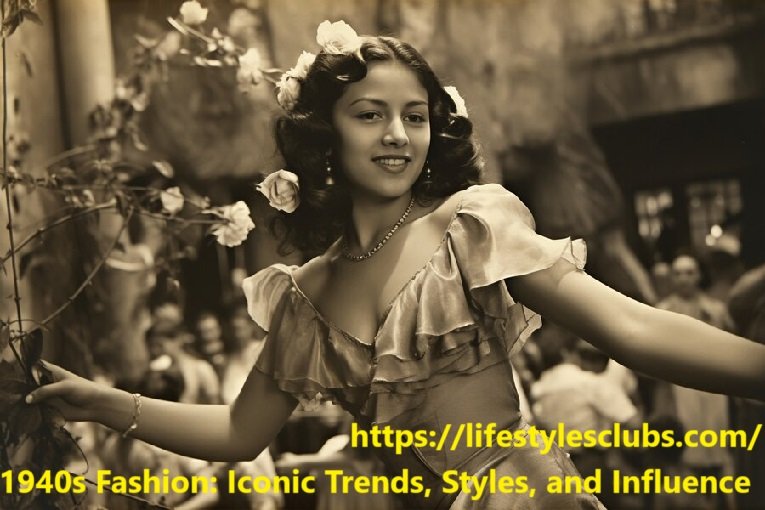The 1940s was a decade marked by both hardship and transformation, and fashion during this time reflected the resilience and adaptability of the era. World War II had a profound impact on daily life, including the way people dressed. Despite rationing and material shortages, the 1940s brought about unique styles that continue to influence fashion today. From utilitarian designs to glamorous Hollywood looks, this era produced iconic trends that have withstood the test of time.
In this guide, we’ll explore the key aspects of 1940s fashion, from wartime practicality to the elegance of post-war couture.
1. The Impact of World War II on Fashion
Rationing and Fabric Restrictions
World War II (1939–1945) dramatically affected fashion as governments introduced strict fabric rationing. Countries like the United States and the United Kingdom imposed restrictions on materials such as wool, silk, nylon, and leather to ensure these resources were directed toward the war effort. As a result, fashion designers had to get creative, focusing on minimalism and practicality while maintaining style.
Utility Clothing
Utility clothing emerged during the war as a government-regulated style that prioritized simplicity and functionality. For women, this meant skirts became shorter to save fabric, and clothing was often made from durable materials like cotton and rayon. Dresses were designed with limited pleats, trims, and buttons to conserve resources. Utility fashion also introduced a standardized approach, where pieces were meant to be mixed and matched for maximum versatility.
The Victory Suit
One of the most iconic pieces of 1940s wartime fashion was the “Victory Suit.” This outfit typically featured a tailored jacket and a pencil skirt or straight-legged trousers. The sharp, clean lines of the suit became a symbol of wartime determination, with its military-inspired design reflecting national pride and resilience.
2. Women’s Fashion in the 1940s
Daywear: Simplicity and Functionality
During the war, women’s daywear focused on practicality. Hemlines rose to conserve fabric, and dresses featured simple, straight cuts with minimal embellishments. A-line skirts were popular, as they allowed women to move easily and comfortably throughout the day. Colors were often muted, with military-inspired tones like navy, olive, and brown dominating wardrobes.
Trousers for Women
A major shift in women’s fashion during the 1940s was the widespread acceptance of trousers. With many women taking on factory and farm work in place of men who had gone to war, pants became a practical necessity. Women’s trousers in the 1940s were high-waisted, wide-legged, and often made from sturdy fabrics. This new trend was not just functional but also empowered women to embrace a more androgynous style, breaking traditional gender norms.
The Wartime Hair and Makeup Look
With fabric shortages, women often compensated by focusing on their hair and makeup to maintain a polished appearance. Hairstyles in the 1940s were characterized by curls, waves, and victory rolls — a style where hair was rolled away from the face, often pinned at the crown. Red lipstick and winged eyeliner were staples of 1940s beauty, adding a pop of glamour to otherwise conservative outfits.
3. Glamour in the 1940s: The Hollywood Influence

Hollywood’s Golden Age
Despite the austerity of the wartime years, Hollywood continued to flourish, providing an escape for the masses and a source of fashion inspiration. Actresses like Katharine Hepburn, Rita Hayworth, and Lauren Bacall set the standard for glamour, even during the difficult years of the war.
Hollywood fashion featured luxurious fabrics like satin and silk, full-length gowns, and hourglass silhouettes. The post-war period in particular saw a return to more glamorous styles, as the fashion world moved away from the constraints of wartime practicality.
The New Look by Christian Dior 1940s Fashion
One of the most significant fashion moments of the 1940s came after the war, in 1947, when French designer Christian Dior introduced his “New Look.” Characterized by a cinched waist, full skirt, and soft, rounded shoulders, the New Look marked a dramatic shift away from wartime austerity. The silhouette emphasized femininity, and it quickly became popular across the globe, influencing women’s fashion well into the 1950s.
4. Men’s Fashion in the 1940s
The Wartime Suit
Men’s fashion in the 1940s was also impacted by the war. The Victory Suit, like its female counterpart, was a key look, characterized by a military-inspired, boxy jacket and narrower trousers. Suits were often made from heavy wool, and colors like charcoal, navy, and brown were predominant.
Military Uniforms as Fashion Statements
Military uniforms were a common sight in the 1940s, with soldiers and civilians alike adopting elements of military fashion into everyday wear. Aviator jackets, pea coats, and bomber jackets became fashionable among men, and they remain popular to this day.
Casual Wear 1940s Fashion
While formal suits were still a staple, casual wear gained popularity among men during the 1940s. Knitwear, like sweaters and cardigans, became a common choice for men during colder months, often paired with trousers or khakis. Plaid shirts, bomber jackets, and leather loafers were also fashionable for men seeking a more relaxed look.
5. Accessories in the 1940s
Hats and Headscarves
Hats were a crucial accessory in the 1940s for both men and women. For women, small hats, often adorned with veils or flowers, were worn to add a touch of elegance to an outfit. Headscarves also became popular, particularly among working women, as they helped keep hair tidy during manual labor.
For men, fedoras and trilby hats were the go-to choices for a stylish yet functional accessory.
Shoes 1940s Fashion
Due to leather shortages during the war, footwear in the 1940s was often practical. Women’s shoes featured sturdy heels and closed toes, with materials like canvas and wood replacing leather. Post-war, fashion shifted toward more elegant styles, with high heels and peep-toe shoes becoming increasingly popular.
Men’s shoes, like loafers and Oxfords, remained simple and durable during the war. After the war, more luxurious materials returned to the market, allowing for a wider variety of styles.
Gloves and Jewelry
Gloves were another important accessory for women in the 1940s, often worn with both day and evening wear. Long gloves were considered elegant and were typically paired with formal gowns for special occasions.
Jewelry during the war years was generally understated, with simple brooches and pearl necklaces being popular choices. However, the post-war period saw a return to more elaborate pieces, with rhinestones, crystals, and other sparkling embellishments becoming popular once again.
6. Post-War Fashion Transition
A Shift Toward Femininity
After the war ended in 1945, fashion underwent a transformation. As restrictions were lifted, designers began to experiment with more lavish fabrics and intricate designs. The previously conservative, utilitarian style of the wartime years gave way to a new focus on femininity and luxury. Dresses featured fuller skirts, softer fabrics, and more vibrant colors, reflecting the sense of hope and renewal that came with the post-war years.
Return to Haute Couture 1940s Fashion
With Paris reclaiming its position as the fashion capital of the world, haute couture saw a resurgence. Designers like Christian Dior, Balenciaga, and Pierre Balmain led the way, offering women the chance to embrace elegance and sophistication after years of austerity.
Conclusion: The Lasting Influence of 1940s Fashion
The 1940s was a decade of resilience, adaptation, and eventual renewal in the world of fashion. Despite the challenges posed by World War II, fashion continued to evolve, and many of the trends that emerged during this time remain relevant today. From the practical styles of utility clothing to the glamorous influences of Hollywood and the revolutionary New Look by Dior, the fashion of the 1940s continues to inspire designers and fashion enthusiasts alike.
Whether you’re drawn to the tailored suits, victory rolls, or elegant gowns of the era, 1940s fashion represents a fascinating blend of practicality and glamour that continues to captivate.
Read More Also: Fashion Pulis
